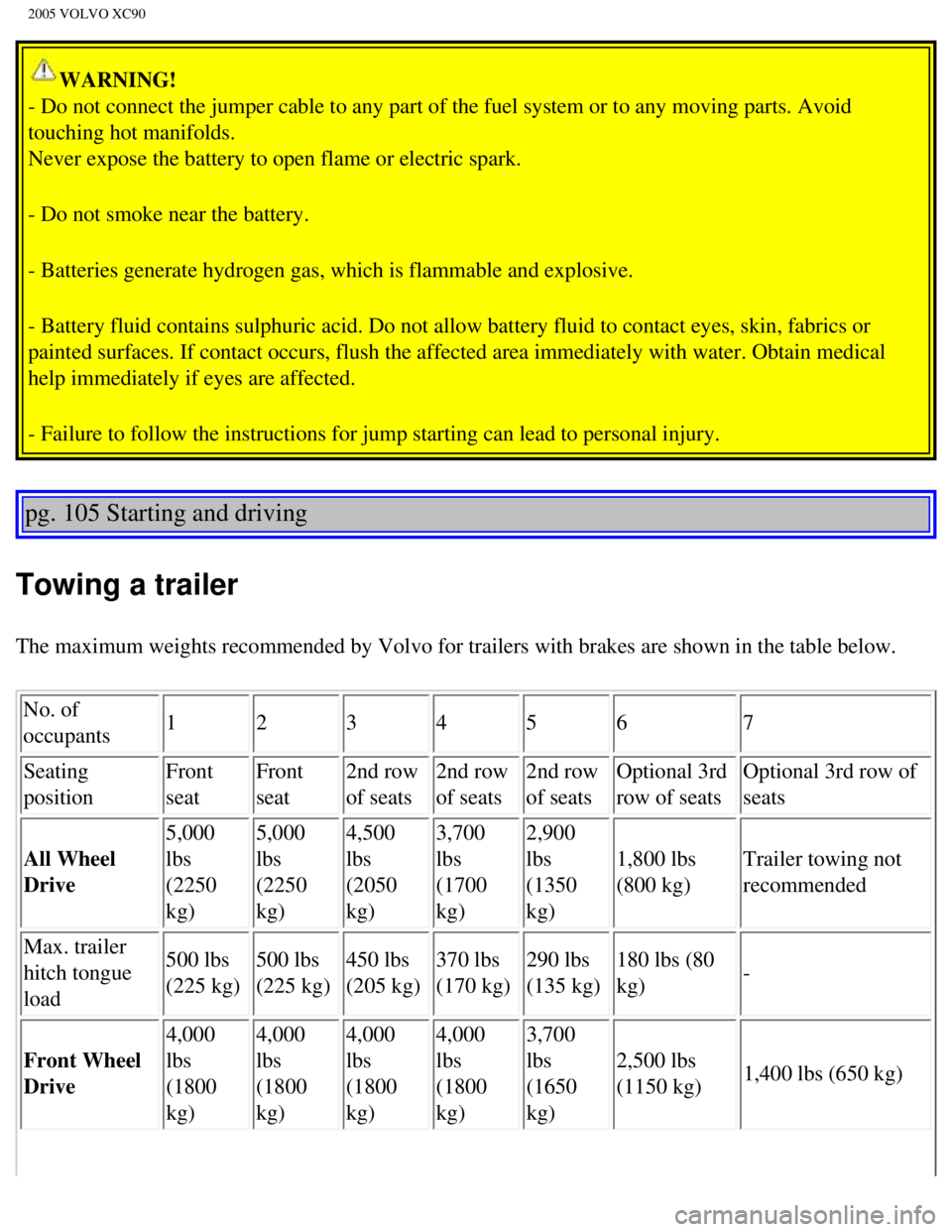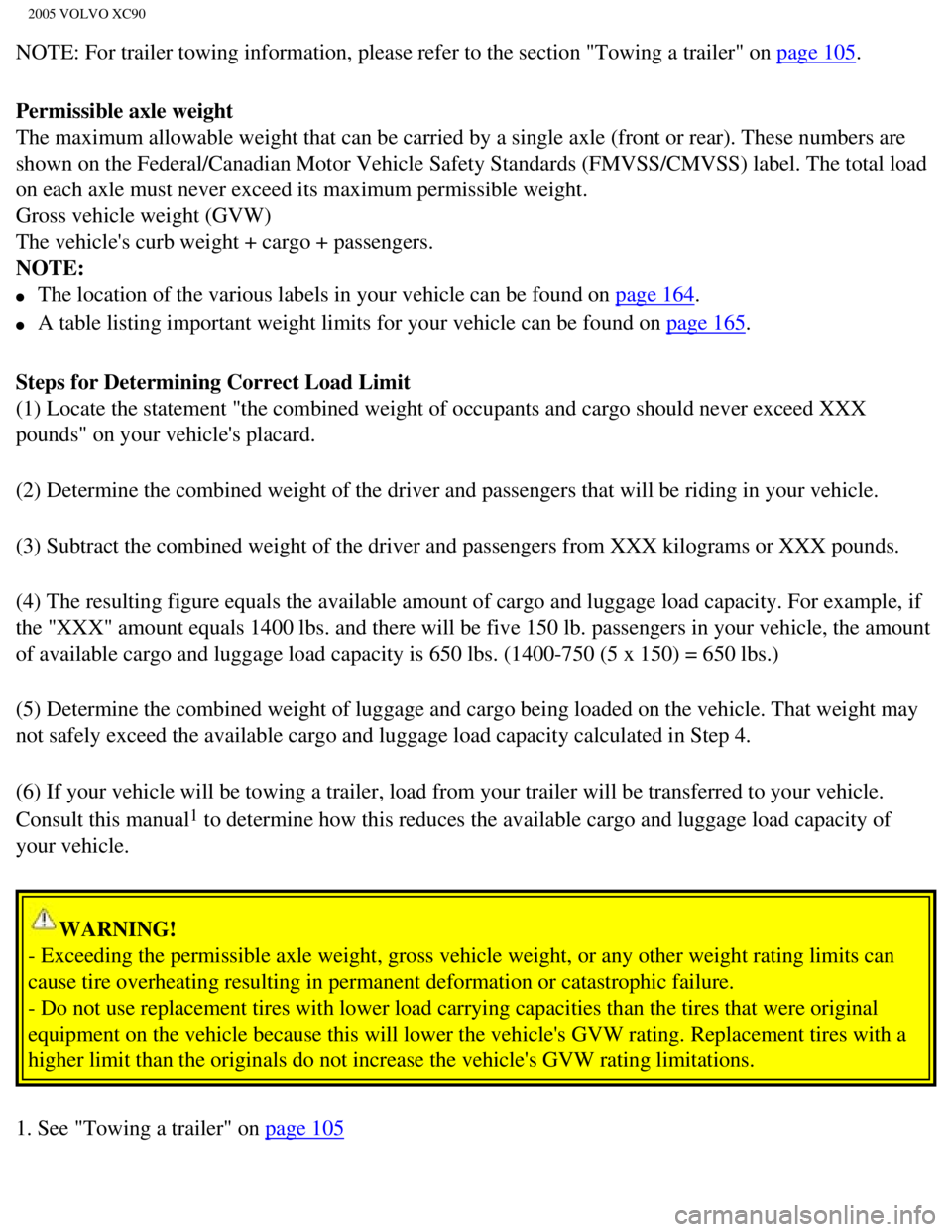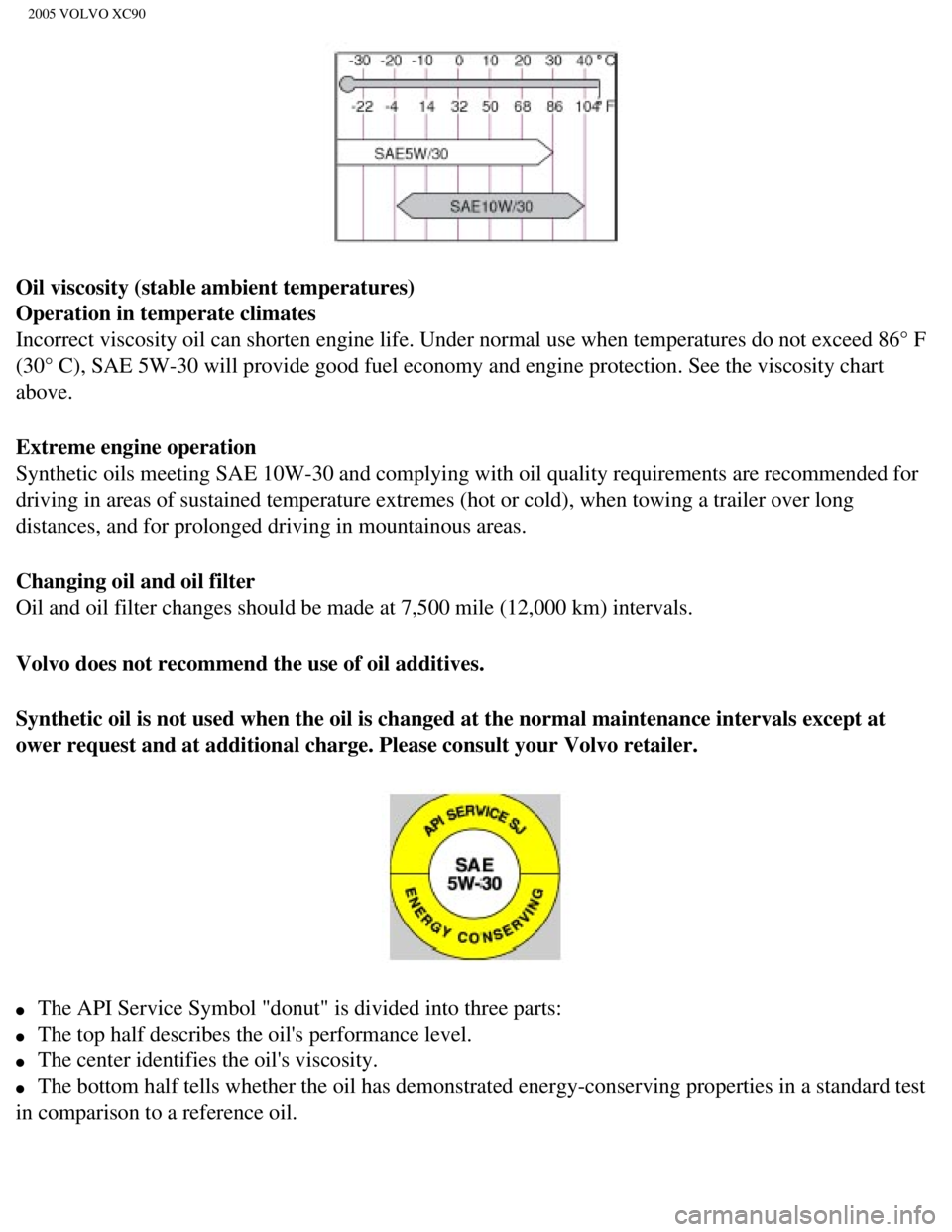2005 VOLVO XC90 towing
[x] Cancel search: towingPage 141 of 263

2005 VOLVO XC90
WARNING!
- Do not connect the jumper cable to any part of the fuel system or to a\
ny moving parts. Avoid
touching hot manifolds.
Never expose the battery to open flame or electric spark.
- Do not smoke near the battery.
- Batteries generate hydrogen gas, which is flammable and explosive.
- Battery fluid contains sulphuric acid. Do not allow battery fluid to c\
ontact eyes, skin, fabrics or
painted surfaces. If contact occurs, flush the affected area immediately\
with water. Obtain medical
help immediately if eyes are affected.
- Failure to follow the instructions for jump starting can lead to perso\
nal injury.
pg. 105 Starting and driving
Towing a trailer
The maximum weights recommended by Volvo for trailers with brakes are sh\
own in the table below.
No. of
occupants 1
2 3 4 5 6 7
Seating
position Front
seat Front
seat 2nd row
of seats2nd row
of seats2nd row
of seatsOptional 3rd
row of seats Optional 3rd row of
seats
All Wheel
Drive 5,000
lbs
(2250
kg)5,000
lbs
(2250
kg)4,500
lbs
(2050
kg)3,700
lbs
(1700
kg)2,900
lbs
(1350
kg)
1,800 lbs
(800 kg)
Trailer towing not
recommended
Max. trailer
hitch tongue
load 500 lbs
(225 kg)
500 lbs
(225 kg)450 lbs
(205 kg)370 lbs
(170 kg)290 lbs
(135 kg)180 lbs (80
kg)
-
Front Wheel
Drive 4,000
lbs
(1800
kg)4,000
lbs
(1800
kg)4,000
lbs
(1800
kg)4,000
lbs
(1800
kg)3,700
lbs
(1650
kg)
2,500 lbs
(1150 kg)
1,400 lbs (650 kg)
file:///K|/ownersdocs/2005/2005_XC90/05xc90_06b.htm (11 of 18)12/30/20\
06 4:42:35 PM
Page 142 of 263

2005 VOLVO XC90
Max. trailer
hitch tongue
load400 lbs
(180 kg)
400 lbs
(180 kg)400 lbs
(180 kg)400 lbs
(180 kg)370 lbs
(165 kg)250 lbs (115
kg)
140 lbs (65 kg)
NOTE:
l Recommended hitch tongue load: not more than 10% of the trailer's weight\
.
The trailer load should be positioned so that it does not shift and the \
tongue load should be 10% of the
trailer's weight. However, the tongue load should not exceed the maximum\
permissible weights
indicated in the table above.
l When towing trailers without brakes, the maximum permissible trailer wei\
ght is 1,700 lbs (750 kg).
l If necessary, redistribute the weight of any cargo in the trailer to avo\
id excessive weight on the trailer
hitch.
l The maximum trailer weight listed in the table for All Wheel Drive model\
s, 5,000 lbs (2250 kg) is
only applicable when there are not more than two occupants in the vehicl\
e, in the front seats, with a
combined weight of 300 lbs (135 kg), with no other cargo in the vehicl\
e.
pg. 106 Starting and driving
Towing a trailer (contd)
l The maximum weight listed for Front Wheel Drive models, 4,000 lbs (1800\
kg) is only applicable
when there are not more than four occupants in the vehicle, in the front\
seats and second row of seats,
with a combined weight of 600 lbs (270 kg), with no other cargo in the\
vehicle.
l Please be aware that the load on the trailer hitch is part of the vehicl\
e's total load carrying capacity.
The amount of cargo in the vehicle and the trailer must be limited so th\
at the gross vehicle weight and
maximum permissible rear axle weight
(see page 165) are not exceeded.
l Vehicles used for towing a trailer on a regular basis, or for long-dista\
nce highway towing should be
equipped with an automatic transmission oil cooler and Volvo's automatic\
self-leveling system for the
rear suspension. Consult your Volvo retailer.
l Volvo recommends the use of Volvo trailer hitches that are specially des\
igned for the vehicle.
l All Volvo models are equipped with energy-absorbing shock-mounted bumper\
s. Trailer hitch
installation should not interfere with the proper operation of this bump\
er system.
l Increase tire pressure to recommended full inflation pressure. See chapt\
er "Wheels and tires."
l When your vehicle is new, avoid towing heavy trailers during the first 6\
20 miles (1,000 km).
l Engine and transmission are subject to increased loads. Therefore, engin\
e coolant temperature should
be closely watched when driving in hot climates or hilly terrain. Use a \
lower gear and turn off the air
conditioner if the temperature gauge needle enters the red range.
l If the automatic transmission begins to overheat, a message will be disp\
layed in the text window.
l Hauling a trailer affects handling, durability, and economy.
l It is necessary to balance trailer brakes with the towing vehicle brakes\
to provide a safe stop (check
and observe state/local regulations).
file:///K|/ownersdocs/2005/2005_XC90/05xc90_06b.htm (12 of 18)12/30/20\
06 4:42:35 PM
Page 143 of 263

2005 VOLVO XC90
l Do not connect the trailer's brake system directly to the vehicle's brak\
e system.
l Remove the ball and drawbar assembly when the hitch is not being used.
l Volvo recommends the use of synthetic engine oil when towing a trailer o\
ver long distances or in
mountainous areas.
WARNING!
- Bumper-attached trailer hitches must not be used on Volvos, nor should\
safety chains be attached to
the bumper.
Trailer hitches attaching to the vehicle rear axle must not be used.
- Never connect a trailer's hydraulic brake system directly to the vehic\
le brake system, nor a trailer's
lighting system directly to the vehicle lighting system. Consult your ne\
arest authorized Volvo retailer
for correct installation.
- When towing a trailer, the trailer's safety wire must be correctly fas\
tened to the hole or hook
provided in the trailer hitch on the vehicle. The safety wire should nev\
er be fastened to or wound
around the drawbar ball.
NOTE!
- When parking the vehicle with a trailer on a hill, apply the parking b\
rake before putting the gear
selector in (P)ark. When starting on a hill, put the gear selector in \
(D)rive before releasing the parking
brake.
- If you use the manual (Geartronic) shift positions while towing a tr\
ailer, make sure the gear you select
does not put too much strain on the engine (using too high a gear).
pg. 107 Starting and driving
Leveling
If your vehicle is equipped with automatic levelling, the rear suspensio\
n always retains the correct ride
height regardless of the load.
l The system adjusts the rear suspension to the correct level after the ve\
hicle has been driven a short
distance.
l When the vehicle is stationary, the rear suspension lowers, which is nor\
mal.
file:///K|/ownersdocs/2005/2005_XC90/05xc90_06b.htm (13 of 18)12/30/20\
06 4:42:35 PM
Page 164 of 263
![VOLVO XC90 2005 Owners Manual
2005 VOLVO XC90
[43 psi (2.9 bar) for Metric tires]. Increasing the inflation pressure\
beyond this pressure will not increase
the tires load carrying capability.
l kPa: Kilopascal, a metric u VOLVO XC90 2005 Owners Manual
2005 VOLVO XC90
[43 psi (2.9 bar) for Metric tires]. Increasing the inflation pressure\
beyond this pressure will not increase
the tires load carrying capability.
l kPa: Kilopascal, a metric u](/manual-img/45/58559/w960_58559-163.png)
2005 VOLVO XC90
[43 psi (2.9 bar) for Metric tires]. Increasing the inflation pressure\
beyond this pressure will not increase
the tires load carrying capability.
l kPa: Kilopascal, a metric unit of air pressure.
l PSI: Pounds per square inch, a standard unit of air pressure.
l B-pillar: The structural member at the side of the vehicle behind the front door\
.
l Bead area of the tire: Area of the tire next to the rim.
l Sidewall of the tire: Area between the bead area and the tread.
l Tread area of the tire: Area of the perimeter of the tire that contacts the road when mounted \
on the
vehicle.
l Rim: The metal support (wheel) for a tire or a tire and tube assembly upo\
n which the tire beads are
seated.
l Maximum load rating: a figure indicating the maximum load in pounds and kilograms that can \
be
carried by the tire. This rating is established by the tire manufacturer\
.
l Maximum permissible inflation pressure: the greatest amount of air pressure that should ever be
put in the tire. This limit is set by the tire manufacturer.
l Recommended tire inflation pressure: inflation pressure, established by Volvo, which is based on
the type of tires that are mounted on a vehicle at the factory. This inf\
lation pressure is affected by the
number of occupants in the car, the amount of cargo, and the speed at wh\
ich the vehicle will be driven
for a prolonged period. This information can be found on the tire inflat\
ion placard(s) located on the
driver's side B-pillar or on the inside of the fuel filler door on Canad\
ian models, and in the tire inflation
table in this chapter.
l Cold tires: The tires are considered to be cold when they have the same temperatur\
e as the
surrounding (ambient) air. This temperature is normally reached after \
the car has been parked for at least
3 hours.
pg. 120 Wheels and tires
Vehicle loading
Properly loading your vehicle will provide maximum return of vehicle des\
ign performance. Before
loading your vehicle, familiarize yourself with the following terms for \
determining your vehicle's weight
ratings, with or without a trailer, from the vehicle's Federal/Canadian \
Motor Vehicle Safety Standards
(FMVSS/CMVSS) label, and the vehicle's tire information placard:
Curb weight
The weight of the vehicle including a full tank of fuel and all standard\
equipment. It does not include
passengers, cargo, or optional equipment.
Capacity weight
All weight added to the curb weight, including cargo and optional equipm\
ent. When towing, trailer hitch
tongue load is also part of cargo weight.
file:///K|/ownersdocs/2005/2005_XC90/05xc90_08.htm (10 of 17)12/30/200\
6 4:42:37 PM
Page 165 of 263

2005 VOLVO XC90
NOTE: For trailer towing information, please refer to the section "Towin\
g a trailer" on page 105.
Permissible axle weight
The maximum allowable weight that can be carried by a single axle (fron\
t or rear). These numbers are
shown on the Federal/Canadian Motor Vehicle Safety Standards (FMVSS/CMV\
SS) label. The total load
on each axle must never exceed its maximum permissible weight.
Gross vehicle weight (GVW)
The vehicle's curb weight + cargo + passengers.
NOTE:
l The location of the various labels in your vehicle can be found on page 164.
l A table listing important weight limits for your vehicle can be found on\
page 165.
Steps for Determining Correct Load Limit
(1) Locate the statement "the combined weight of occupants and cargo s\
hould never exceed XXX
pounds" on your vehicle's placard.
(2) Determine the combined weight of the driver and passengers that wi\
ll be riding in your vehicle.
(3) Subtract the combined weight of the driver and passengers from XXX\
kilograms or XXX pounds.
(4) The resulting figure equals the available amount of cargo and lugg\
age load capacity. For example, if
the "XXX" amount equals 1400 lbs. and there will be five 150 lb. passeng\
ers in your vehicle, the amount
of available cargo and luggage load capacity is 650 lbs. (1400-750 (5 \
x 150) = 650 lbs.)
(5) Determine the combined weight of luggage and cargo being loaded on\
the vehicle. That weight may
not safely exceed the available cargo and luggage load capacity calculat\
ed in Step 4.
(6) If your vehicle will be towing a trailer, load from your trailer w\
ill be transferred to your vehicle.
Consult this manual
1 to determine how this reduces the available cargo and luggage load capa\
city of
your vehicle.
WARNING!
- Exceeding the permissible axle weight, gross vehicle weight, or any ot\
her weight rating limits can
cause tire overheating resulting in permanent deformation or catastrophi\
c failure.
- Do not use replacement tires with lower load carrying capacities than \
the tires that were original
equipment on the vehicle because this will lower the vehicle's GVW ratin\
g. Replacement tires with a
higher limit than the originals do not increase the vehicle's GVW rating\
limitations.
1. See "Towing a trailer" on
page 105
file:///K|/ownersdocs/2005/2005_XC90/05xc90_08.htm (11 of 17)12/30/200\
6 4:42:37 PM
Page 179 of 263

2005 VOLVO XC90
Oil viscosity (stable ambient temperatures)
Operation in temperate climates
Incorrect viscosity oil can shorten engine life. Under normal use when t\
emperatures do not exceed 86° F
(30° C), SAE 5W-30 will provide good fuel economy and engine protec\
tion. See the viscosity chart
above.
Extreme engine operation
Synthetic oils meeting SAE 10W-30 and complying with oil quality require\
ments are recommended for
driving in areas of sustained temperature extremes (hot or cold), when\
towing a trailer over long
distances, and for prolonged driving in mountainous areas.
Changing oil and oil filter
Oil and oil filter changes should be made at 7,500 mile (12,000 km) in\
tervals.
Volvo does not recommend the use of oil additives.
Synthetic oil is not used when the oil is changed at the normal maintena\
nce intervals except at
ower request and at additional charge. Please consult your Volvo retaile\
r.
l The API Service Symbol "donut" is divided into three parts:
l The top half describes the oil's performance level.
l The center identifies the oil's viscosity.
l The bottom half tells whether the oil has demonstrated energy-conserving\
properties in a standard test
in comparison to a reference oil.
file:///K|/ownersdocs/2005/2005_XC90/05xc90_09a.htm (8 of 14)12/30/200\
6 4:42:39 PM
Page 250 of 263

2005 VOLVO XC90
2 0 0 5
VOLVO XC90
Index
pg. 199-203 Index
A
A/C (air conditioning)
54
ABS
ii, 27, 98
Adjustable steering wheel
35
Air bags - dual threshold/stage
5
Air cleaner
140
Air distribution
51, 54
Air Quality sensor
55
Air vents
51
Airbag - Side Impact (SIPS)
12
Alarm
82
All Wheel Drive
96
All Wheel Drive - towing
103
Anchorages, for child seats
21
Anti-lock Brake System (ABS)
ii, 27
Approach lighting
35
Ashtray
43, 68
Audio system
175
AUTO (climate control)
53
Automatic climate control, ECC
52
Automatic gearbox
91
Automatic Locking Retractor
22
file:///K|/ownersdocs/2005/2005_XC90/05xc90_12.htm (1 of 14)12/30/2006\
4:42:46 PM
Page 259 of 263

2005 VOLVO XC90
Text window - messages 30
Three-way catalytic converter
170
TIME FOR REGULAR SERVICE
30
Tire designations
118
Tire inflation
113
Tire inflation pressure table
115
Tire Pressure Monitoring System
29, 116
Tire pressure, checking
113
Tire terminology
119
Tires, changing
124
Tires
112
Towing
102
Towing - cars with All Wheel Drive
103
Towing a trailer
105
Trailer indicator lamp
29
Trailer towing
105
Transmission - Geartronic
93
Tread wear indicator
112
Treble
181
Trip computer
39
Trip odometer
26
Turn signals
35
U
Uniform Tire Quality Grading
128
Unlocking the vehicle
79
Upholstery, cleaning
132
V
Valet key
76
Vanity mirror
66
Vehicle Identification Number (VIN)
164
Vehicle loading
120
VIN (Vehicle Identification Number)
164
file:///K|/ownersdocs/2005/2005_XC90/05xc90_12.htm (10 of 14)12/30/200\
6 4:42:46 PM